
Each year, in the middle of October I like to spend as much time as possible out in the Caledonian Forest, to appreciate the beauty of the trees in the richness of their autumn colours, and to indulge my passion for photographing them at this most special season. This year I was out in Glen Affric for a day, and although there was lots of colour in both the birch trees (Betula pendula and Betula pubescens) and the bracken (Pteridium aquilinum), my attention was taken up for part of the day by something else – the bark of a large Scots pine (Pinus sylvestris).
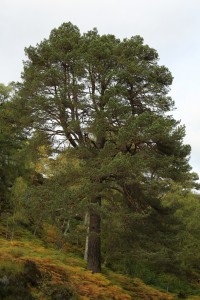
I was in the area on the north side of Loch Beinn a’Mheadhoin, near the road and below the Coille Ruigh na Cuileige exclosure, which I wrote about in my last blog. There’s a large Scots pine there which is a particular favourite of mine, because of its distinctive shape and substantial size. It’s situated beside the road, and marks the place where the informal trail goes up to the Coille Ruigh exclosure. It’s special to me as I love it’s shape – it has a large solid, straight trunk lower down, which then splits into three main branches about half way up, giving it a large spreading canopy with multiple parallel stems. I call it the ‘Trident’ tree as it reminds me of the three-pronged spear carried by Neptune or Poseidon in classical Greek mythology. It’s one of the most impressive pines I know of in Glen Affric, and in its imposing presence it seems to me almost like the gatekeeper for the route to our first exclosure, and the naturally regenerating trees there, up the hill.
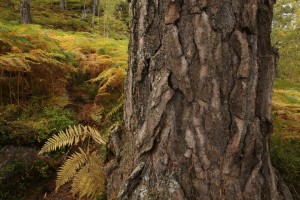
I was planning to go a bit further up the slope, to look for birches at the peak of their autumn colour, but somehow this large pine seemed to call to me on this day, so I decided to have a closer look at it. As so often happens, this was the cue for my day to take a different turn to what I’d planned, and I spent the next hour or so exploring and appreciating the remarkable bark on this tree. While I’ve often looked at this tree when I’ve passed it by, I realised that I’d never truly looked closely at its trunk until now ….
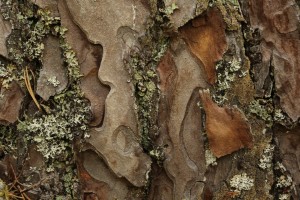
My attention was drawn by the pattern of the plates on the bark near the base of the tree’s trunk. These plates are each individually shaped and probably as unique in their own way as every single snowflake is different from all others. They are irregular and naturally organic in their forms, and are comprised of multiple layers of bark, which can be up to 3 inches (7.5 cm.) in thickness on a large mature tree like this one. The layers separate from each other, revealing their individual jigsaw puzzle-like shapes and how they all interlock and overlap with each other.
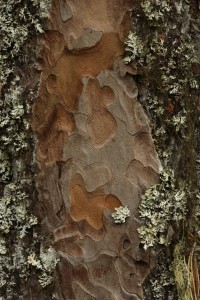
When the layers separate, pieces of the bark flake off, revealing different colours underneath. The fresher bark is reddish-brown, and as it weathers when it’s exposed to the air it turns more grey.
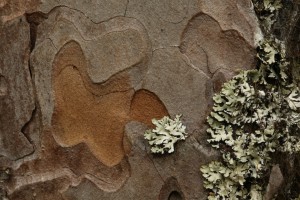
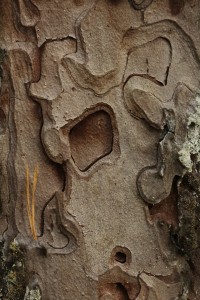
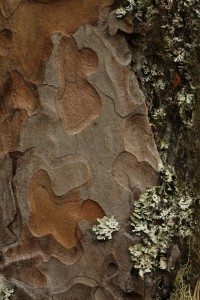
As I looked closely at the tree’s trunk, I began to see more and more examples of what I term Nature’s works of art – beautiful, visually-aesthetic shapes and patterns in the bark plates, and their contrast with the lichens that grow on the trunk. It was a whole little of world of wonder that I opened up to, finding numerous sections of the trunk that were different and unique.
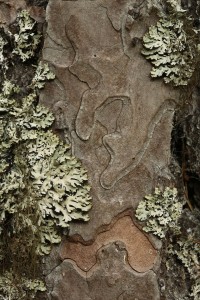
While some sections of the bark were fully exposed, others had variously-sized patches of lichens growing over them, of which heather rags lichen (Hypogymnia physodes) was the most abundant.

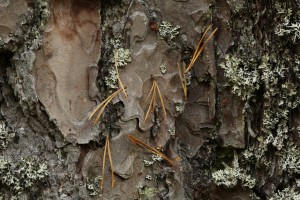
The fissures and crevices between the different sections or plates of the bark are the habitat for a range of invertebrates, including spiders that catch some of the insects that live there. The spiders themselves are rarely seen, because they wait, out of sight in the crevices, for unwary mini-beasts to wander by. The silk threads they use to trap their prey are normally invisible to the naked eye, but their locations are sometimes given away by the pine needles that get caught on them. Although this shows us where the silk is, it’s unlikely to provide a similar benefit to the spider’s potential victims, as they don’t have the advantage of the same visual perspective that we have.
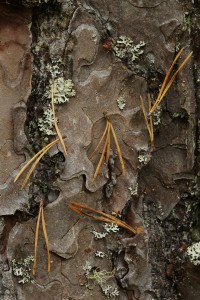
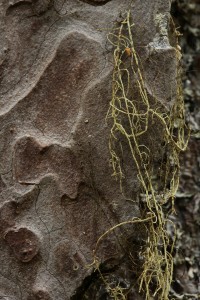
I didn’t see any spiders on the tree’s trunk this particular day, but as I continued looking at the bark at about eye level, I found other interesting patterns of bark shapes and lichens. One of the other lichens occurring on the bark of this tree was a beard lichen (Usnea sp.).
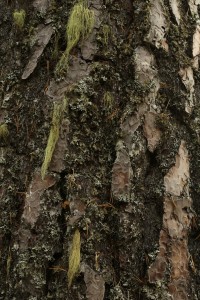
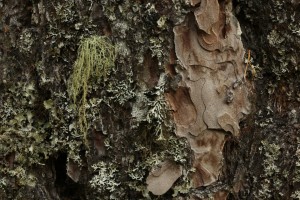
There are several closely-related species in this genus, and I haven’t yet learned the skill of telling them apart from each other…
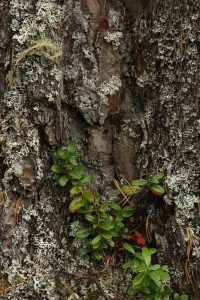
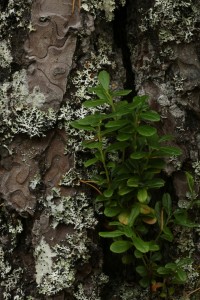
At the base of the tree there was another element added to the natural artwork formed by the bark and the lichens growing on it. In several places cowberry plants (Vaccinium vitis-idaea) were climbing up the bark, bringing a contrasting colour of deep green to the reddish-brown of the bark and the silver grey of the lichens.
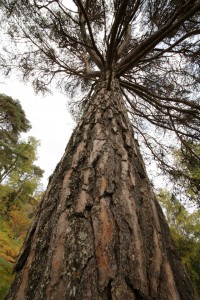
As I continued to discover more and more interesting works of natural art on the bark, I realised I was only seeing a tiny fraction of the pine’s total bark area. That reached for many metres above me, with there no doubt being numerous other beautiful patterns stretching up the length of the trunk, that I couldn’t see from the ground.
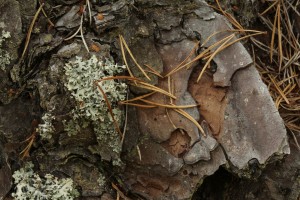
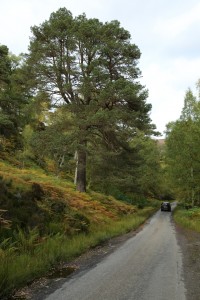
If I’d been able to climb up the tree, I could no doubt have spent the rest of the day exploring the bark up to where the main branches divided off the trunk, and taking a lot more photographs, all of which would have revealed unique and different shapes and patterns.
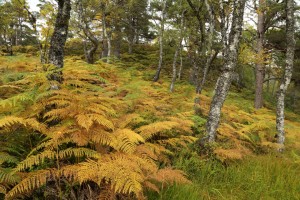
However, after having spent more than an hour with this tree, I decided to move on, and I continued up the hill a little further, passing an area with a lot of bracken that was brilliant yellow in colour.
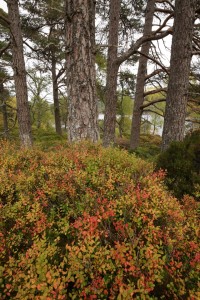
As I reached the top of a small rise, my eye was drawn by a group of Scots pines, with a brightly-coloured patch of blaeberries (Vaccinium myrtillus) growing on a hummock beneath them.
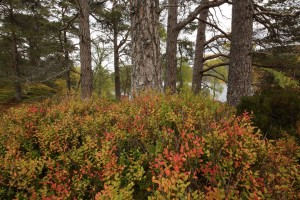
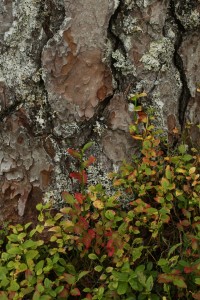
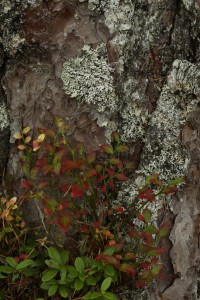
This has been a particularly good year for the colour of the blaeberries – there’s many more bright red patches than usual. Often the blaeberry leaves turn a relatively dull yellow before being shed for the winter, but somehow the conditions this year must have contributed to making them much more brilliant, and when seen en masse like this, they are quite spectacular.
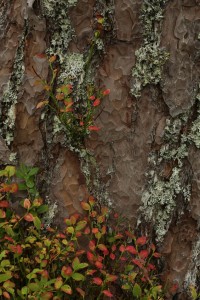
As I approached the base of the pines, I realised there was another whole world of natural artwork here, with the colourful blaeberries contrasting with the patterns of the bark shapes and the lichens growing on them.
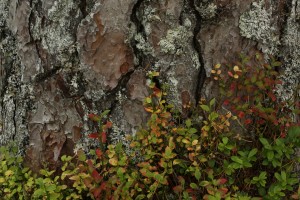
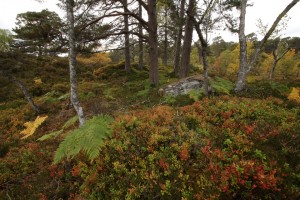
I could easily have spent many more hours exploring the bark patterns on each of the pines in this area, but the daylight was beginning to fade and it was time to leave. While my intention for the day had been to concentrate on the autumn colours of the trees, I’d found instead great delight in the constantly varying beauty of the pine bark, and considerable creative satisfaction in framing these natural artworks with my photographs. While some people might have thought it strange to spend most of a day looking at the bark of a few trees, I left the glen with a renewed sense of appreciation and awe for the diversity and wonder that is embodied by all the life in the Caledonian Forest, and deeply satisfied with how I’d spent my day there.
It is deeply touching and empowering to know that so many of us spend time to exchange with the tree beings. Listening to what they have to teach us. Admiring their many ways of expression.
Talking about the beauty of trees, is there a “right” or sensible way to have a christmas tree standing in our homes? Does Trees for Life have a set of suggestions to make on that topic? There is a lot of information online, but it’s always more valuable to hear from a trusted voice.
So much joy in looking at the detail and keeping a fresh, open mind. Nature is always different and new so always worth a closer look.
Hi Jiva,
Yes, absolutely – the same place is different every day when I look closely enough. There’s always something new to see.
With best wishes,
Alan
Right hand side, sixth image down: I see the face of a white dog with a black patch
over it’s eye.
Hi Maggie,
Ah yes, at the right hand edge of the image – I hadn’t seen that myself before! Thanks for pointing it out.
With best wishes,
Alan
Wonderful blog post, Alan, as ever! Thanks for the effort.
Hi Martin,
Many thanks for the positive feedback. Comments like yours ensure that I’ll keep on making these blogs as informative and visually interesting as possible.
With best wishes,
Alan
Thanks for sharing this Alan. When one takes the time to study the details, it is absolutely amazing the endless variety of beautiful shapes that nature produces. In recent years I have taken an interest in the astounding variety of wildflowers that parade across our landscape throughout the spring, summer and fall, and by extension, the incredible variety of butterflies that one comes across at the same time.
Thanks again for your always interesting blog.
Hi John,
Yes, there’s a whole world to discover in the finer details within everything in Nature. I’m glad that you’re finding my blogs interesting – I’ll keep them coming!
With best wishes,
Alan